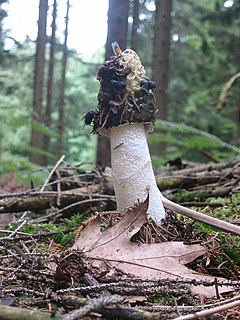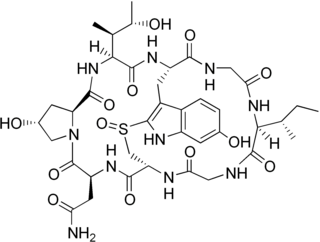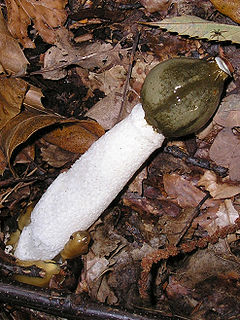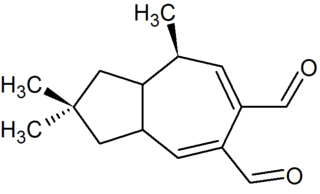Chemical synthesis is the artificial execution of useful chemical reactions to obtain one or several products. This occurs by physical and chemical manipulations usually involving one or more reactions. In modern laboratory uses, the process is reproducible, reliable, and established to work the same in multiple laboratories.

Muscarine, L-(+)-muscarine, or muscarin is a natural product found in certain mushrooms, particularly in Inocybe and Clitocybe species, such as the deadly C. dealbata. Mushrooms in the genera Entoloma and Mycena have also been found to contain levels of muscarine which can be dangerous if ingested. Muscarine has been found in harmless trace amounts in Boletus, Hygrocybe, Lactarius and Russula. Muscarine is only a trace compound in the fly agaric Amanita muscaria; the pharmacologically more relevant compounds from this mushroom are ibotenic acid and muscimol. A. muscaria fruitbodies contain a variable dose of muscarine, usually around 0.0003% fresh weight. This is very low and toxicity symptoms occur very rarely. Inocybe and Clitocybe contain muscarine concentrations up to 1.6%.

Phallaceae is a family of fungi, commonly known as stinkhorn mushrooms, within the order Phallales. Stinkhorns have a worldwide distribution, but are especially prevalent in tropical regions. They are known for their foul-smelling, sticky spore masses, or gleba, borne on the end of a stalk called the receptaculum. The characteristic fruiting-body structure, a single, unbranched receptaculum with an externally attached gleba on the upper part, distinguishes the Phallaceae from other families in the Phalalles. The spore mass typically smells of carrion or dung, and attracts flies, beetles and other insects to help disperse the spores. Although there is great diversity in body structure shape among the various genera, all species in the Phallaceae begin their development as oval or round structures known as "eggs". According to a 2008 estimate, the family contains 21 genera and 77 species.

Orellanine or orellanin is a mycotoxin found in a group of mushrooms known as the Orellani of the Cortinariaceae family. Structurally, it is a bipyridine N-oxide compound somewhat related to diquat.

Paclitaxel total synthesis in organic chemistry is a major ongoing research effort in the total synthesis of paclitaxel (Taxol). This diterpenoid is an important drug in the treatment of cancer but, also expensive because the compound is harvested from a scarce resource, namely the Pacific yew. Not only is the synthetic reproduction of the compound itself of great commercial and scientific importance, but it also opens the way to paclitaxel derivatives not found in nature but with greater potential.

Tropolone is an organic compound with the formula C7H5(OH)O. It is a pale yellow solid that is soluble in organic solvents. The compound has been of interest to research chemists because of its unusual electronic structure and its role as a ligand precursor. Although not usually prepared from tropone, it can be viewed as its derivative with a hydroxyl group in the 2-position.

gamma-Amanitin or γ-amanitin is a cyclic peptide of eight amino acids. It is an amatoxin, a group of toxins isolated from and found in several members of the mushroom genus Amanita, one being the death cap as well as the destroying angel, a complex of similar species, principally A. virosa and A. bisporigera. The compound is highly toxic, inhibits RNA polymerase II, disrupts synthesis of mRNA, and can be fatal.

The genus Phallus, commonly known as stinkhorns, are a group of basidiomycetes which produce a phallic, often foul-scented, mushroom, from which their name is derived. The genus has a widespread distribution and, according to a 2008 estimate, contains 18 species. They belong to the family Phallaceae in the order Phallales. The best known species is the common stinkhorn.

Phallus impudicus, known colloquially as the common stinkhorn, is a widespread fungus recognizable for its foul odor and its phallic shape when mature, the latter feature giving rise to several names in 17th-century England. It is a common mushroom in Europe and North America, where it occurs in habitats rich in wood debris such as forests and mulched gardens. It appears from summer to late autumn. The fruiting structure is tall and white with a slimy, dark olive colored conical head. Known as the gleba, this material contains the spores, and is transported by insects which are attracted by the odor—described as resembling carrion. Despite its foul smell, it is not poisonous and immature mushrooms are consumed in parts of France and Germany.

Phallus ravenelii, commonly known as Ravenel's stinkhorn, is a fungus found in eastern North America. Its mushrooms commonly grow in large clusters and are noted for their foul odor and phallic shape when mature. It is saprobic, and as such it is encountered in a wide variety of habitats rich in wood debris, from forests to mulched gardens or sawdust piles in urban areas. It appears from August to October. The fruit body emerges from a pink or lavender-colored egg to form a tall, cylindrical, hollow and spongy white stalk with a bell-shaped cap. The remains of the egg persist as a white to pink or lilac volva at the base of the stalk. The cap is covered in a foul-smelling olive-green spore slime, which attracts insects that help to spread the spores. Sometimes, the cap has a "veil" attached—a thin membrane that hangs underneath. The lack of a roughly ridged and pitted cap differentiates it from the closely related Phallus impudicus. The fungus is named after Henry William Ravenel, a botanist who first discovered it in 1846, though it remained undescribed until 1873. It is considered to be an edible mushroom while in its egg form.

Phallus duplicatus is a species of fungus in the stinkhorn family. The bell-shaped to oval cap is green-brown, the cylindrical stalk is white. When mature the cap becomes sticky with a slimy green coating that attracts flies that disperse its spores, and it has a distinct, "netted" universal veil. The fungus is edible when still in the "egg" stage, before the fruit body has expanded. It grows often in public lawns, and can also be found in meadows.

Phallus hadriani, commonly known as the dune stinkhorn, is a species of fungus in the Phallaceae (stinkhorn) family. It is a widely distributed species, and is native to Asia, Europe, and North America. In Australia, it is probably an introduced species. The stalk of the fruit body reaches up to 20 cm (7.9 in) tall by 4 cm (1.6 in) thick, and is spongy, fragile, and hollow. At the top of the stem is a ridged and pitted, thimble-like cap over which is spread olive-colored spore slime (gleba). Shortly after emerging, the gleba liquefies and releases a fetid odor that attracts insects, which help disperse the spores. Said to be edible in its immature egg-like stage, it typically grows in public lawns, yards and gardens, usually in sandy soils. Phallus hadriani may be distinguished from the similar P. impudicus by the presence of a pink or violet-colored volva at the base of the stem, and by differences in odor.

Eletefine is an isoquinoline alkaloid first isolated in 1998 from Cissampelos glaberrima. It is one of few known compounds containing the so-called stephaoxocane skeleton, alongside stephaoxocanidine, excentricine, and the stephalonganines.

Agaritine (AGT) is an aromatic, antiviral, hydrazine-derivative mycotoxin and IARC Group 3 carcinogen that occurs in mushroom species of the genus Agaricus.

Haematopodin is the more stable breakdown product of Haematopodin B. Both compounds are found in the mushroom Mycena haematopus, although haematopodin only occurs in trace amounts in fresh fruit bodies. Similar pigments, known as batzellins and damirones, have been found in sea sponges. A chemical synthesis for haematopodin was reported in 1996. Key steps in the synthesis involved the addition of 3-[(2,4-dimethoxybenzyl)amino]-1-propanol to the indolo-6,7-quinone and cyclization of the resulting adduct with trifluoroacetic acid.

Capnellene is a naturally occurring tricyclic hydrocarbon derived from Capnella imbricata, a species of soft coral found in Indonesia. Since the 1970s, capnellene has been targeted for synthesis by numerous investigators due to its stereochemistry, functionality, and the interesting geometry of the carbon skeleton. Many alcohol derivatives of capnellene have demonstrated potential as a chemotherapeutic agent with antibacterial, anti-inflammatory and anti-tumor properties.

Velleral (2,2,8-trimethyl-3,3a,8,8a-tetrahydro-1H-azulene-5,6-dicarbaldehyde) is a sesquiterpene dialdehyde found in certain mushrooms, like Lactarius torminosus and Lactarius vellereus, after which it was named. The compound is thought to be part of a chemical defense system that protects the mushrooms against predation. First isolated in 1969, and characterized structurally in 1973, velleral has antimicrobial activity. Several syntheses have been devised.

Ustalic acid is a naturally occurring chemical compound found in the poisonous mushroom Tricholoma ustale.
Medicinal fungi are those fungi which produce medically significant metabolites or can be induced to produce such metabolites using biotechnology. The range of medically active compounds that have been identified include antibiotics, anti-cancer drugs, cholesterol inhibitors, psychotropic drugs, immunosuppressants and even fungicides. Although initial discoveries centred on simple moulds of the type that cause spoilage of food, later work identified useful compounds across a wide range of fungi.























